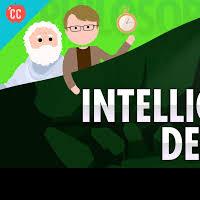11a. Intelligent Design. Part 1/2.
Crash Course Philosophy is brought to you by Squarespace. Squarespace: share your passion with the world.
Over the centuries, the effort to craft a perfect, bullet-proof argument for the existence of God has taken many forms. There was the ontological argument of Anselm. There were the four cosmological arguments of Aquinas. And they still have their supporters. But many modern philosophers feel that they're simply too flawed -- too inconsistent with our scientific understanding of the universe -- to be convincing today.
But there was a fifth argument posited by Thomas Aquinas. And it was popularized several hundred years after his time -- in the late 1700s, by the English Christian philosopher William Paley. And this argument for God's existence is still around today, too. In fact, it's one of the most popular. It's known as the teleological argument. You may know it as Intelligent Design.
[Theme Music]
To make his case for the existence of God, William Paley gave us what's known as an argument by analogy. This form of inductive argument invites us to consider a particular state of affairs -- let's just call it Situation A -- about which we're already likely to have certain beliefs, and then likens it to Situation B, with which we are less familiar.
The idea is that, in the interest of consistency, whatever conclusions we've drawn about A, we ought to draw about B as well. You can make an argument by analogy about anything, but Paley used it to talk about God, in what's known as the Watchmaker Analogy. He asked us to imagine what we'd think if we found a watch on the ground. Would we imagine that the watch simply appeared randomly, spontaneously, on its own? Or would we see the complexity of it, and notice that its parts seem to come together in a particular way in order to accomplish a goal? If so, wouldn't we think that the watch must have been made by someone, on purpose?
Paley was arguing that the teleology demonstrated by a watch would lead us to conclude that it was designed by an intelligent creator with a particular end in mind.
Teleological means goal-oriented, or purposeful. And we can easily pick out the teleologies of man-made objects. Got a mug here, as an example -- it was created with a particular teleology in mind. It was designed to hold a liquid without leaking. It's got a handle put here deliberately, in such a way that human fingers could easily fit into it. And its composition is such that it'll keep the liquid inside warm without burning the hand that holds it.
We wouldn't assume that a coffee cup would simply come to be, exhibiting such perfect design for its particular function, without someone having created it that way on purpose. So, in the same way that the teleology of a cup implies the existence of a cup maker, and that of a watch implies the existence of a watchmaker, Paley saw teleology in the world, and assumed from that, God's existence.
He continued his analogy by comparing a watch to a living organism. Look at the complexity of the human body. Heart and lungs working together, producing sweat to keep ourselves from overheating, transforming food into energy – we're just generally amazing all around.Look at how elements of the natural world operate according to complex laws that sustain a beautiful, natural harmony. Paley said this couldn't possibly just have happened, any more than the design of a pocket watch could just have happened. There must be a designer.
If you accept this analogy, then you agree with Paley that, just like the purposefulness of a watch compels us to believe in a watchmaker, the purposefulness of the world compels us to believe in a worldmaker – God. And you might think this is a fantastic argument. It might even be what motivates your own belief in God.
There are lots of people who say things like sunsets and babies show them that there must be a designer-god. But some of you probably aren't buying it – and you know what to do! Arguments are refuted by counterarguments, so when you want to refute an argument by analogy, you offer a disanalogy. Basically, you demonstrate that Situation A and Situation B are dissimilar enough that the analogy doesn't actually work.
So, to object to Paley, we have to identify a way in which elements of the natural world – like human bodies – are relevantly dissimilar to watches. When we're talking about a watch, an objector might say, it obviously had a creator. After all, we can take it apart and see clearly how the gears fit together to move the hands and keep time. But there's so much in the natural world that isn't understandable in the same way.
For instance, why would God have designed our eyes to have a blind spot? Paley responded that it doesn't matter whether we can understand how something was created. The point is simply that it was. He might point out, for instance, that I actually don't understand the inner workings of my phone. But I still know it had a creator. Whether or not I can understand how it was created is beside the point.

